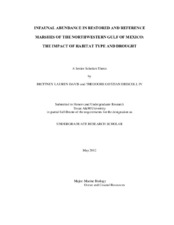Infaunal Abundance In Restored and Refernce Marhses of the Northwestern Gulf of Mexico: the impact of habitat type and drought
Abstract
To date, over 50% of historical tidal marsh habitat in the U.S. has been lost. A widely accepted approach to mitigate the loss of valuable ecological services is marsh restoration, which includes using excavated soil or dredge fill, arranged in either mounds or terraces, to return areas of open water to marsh elevation. Most mitigation projects focus on plant canopy structure and are considered successful within only a few years. However, many aspects of marsh ecology are important including the infaunal community which is much slower to develop. Infaunal organisms are ecosystem engineers that decompose organic matter, oxygenate the soil, and provide trophic support for primary consumers. Site morphology (e.g., elevation, marsh edge, proportion of low marsh habitat) and soil characteristics can strongly influence the infaunal community. Our objective was to determine the links between total soil organic content,marsh design, infaunal densities, and richness in a recently restored brackish marsh in east Texas. Sediment cores were collected at multiple elevations from one reference and four restored areas (excavated, filled, pumped, and terrace) that varied in shape and sediment type in October 2010, July 2011, and November 2011. No relationship between organic content and infaunal density was present among habitat types during October 2010, July 2011, or November 2011. However, in October 2010, densities were significantly different among habitat types, which suggest that infauna may be influenced by morphology. In July 2011 and November 2011, there were no differences among habitat types. Infaunal densities were highest in the pumped sites on all sampling dates except October 2010. In 2011, there was also a qualitative shift in community structure towards stress tolerant organisms such as Capitellids. Community changes in 2011 were likely attributable to stressful environmental conditions caused by an exceptional drought. Therefore, the influence of habitat type on the infaunal community may be most pronounced under environmentally benign conditions and reduced in more stressful conditions such as droughts.
Citation
Davis, Brittney (2012). Infaunal Abundance In Restored and Refernce Marhses of the Northwestern Gulf of Mexico: the impact of habitat type and drought. Honors and Undergraduate Research. Available electronically from https : / /hdl .handle .net /1969 .1 /154436.


